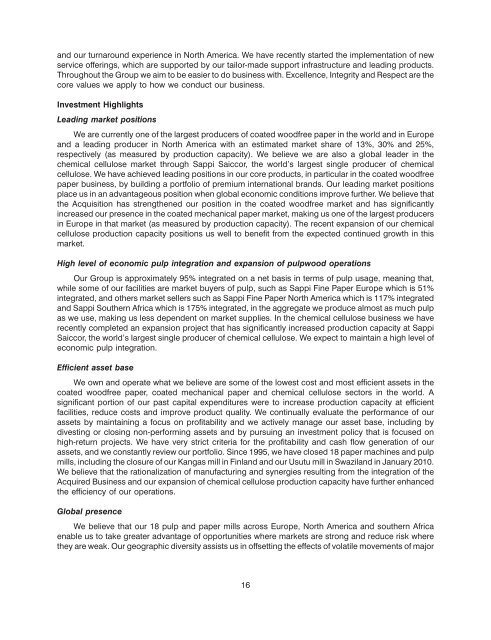You also want an ePaper? Increase the reach of your titles
YUMPU automatically turns print PDFs into web optimized ePapers that Google loves.
and our turnaround experience in North America. We have recently started the implementation of new<br />
service offerings, which are supported by our tailor-made support infrastructure and leading products.<br />
Throughout the Group we aim to be easier to do business with. Excellence, Integrity and Respect are the<br />
core values we apply to how we conduct our business.<br />
Investment Highlights<br />
Leading market positions<br />
We are currently one of the largest producers of coated woodfree paper in the world and in Europe<br />
and a leading producer in North America with an estimated market share of 13%, 30% and 25%,<br />
respectively (as measured by production capacity). We believe we are also a global leader in the<br />
chemical cellulose market through Sappi Saiccor, the world’s largest single producer of chemical<br />
cellulose. We have achieved leading positions in our core products, in particular in the coated woodfree<br />
paper business, by building a portfolio of premium international brands. Our leading market positions<br />
place us in an advantageous position when global economic conditions improve further. We believe that<br />
the Acquisition has strengthened our position in the coated woodfree market and has significantly<br />
increased our presence in the coated mechanical paper market, making us one of the largest producers<br />
in Europe in that market (as measured by production capacity). The recent expansion of our chemical<br />
cellulose production capacity positions us well to benefit from the expected continued growth in this<br />
market.<br />
High level of economic pulp integration and expansion of pulpwood operations<br />
Our Group is approximately 95% integrated on a net basis in terms of pulp usage, meaning that,<br />
while some of our facilities are market buyers of pulp, such as Sappi Fine Paper Europe which is 51%<br />
integrated, and others market sellers such as Sappi Fine Paper North America which is 117% integrated<br />
and Sappi Southern Africa which is 175% integrated, in the aggregate we produce almost as much pulp<br />
as we use, making us less dependent on market supplies. In the chemical cellulose business we have<br />
recently completed an expansion project that has significantly increased production capacity at Sappi<br />
Saiccor, the world’s largest single producer of chemical cellulose. We expect to maintain a high level of<br />
economic pulp integration.<br />
Efficient asset base<br />
We own and operate what we believe are some of the lowest cost and most efficient assets in the<br />
coated woodfree paper, coated mechanical paper and chemical cellulose sectors in the world. A<br />
significant portion of our past capital expenditures were to increase production capacity at efficient<br />
facilities, reduce costs and improve product quality. We continually evaluate the performance of our<br />
assets by maintaining a focus on profitability and we actively manage our asset base, including by<br />
divesting or closing non-performing assets and by pursuing an investment policy that is focused on<br />
high-return projects. We have very strict criteria for the profitability and cash flow generation of our<br />
assets, and we constantly review our portfolio. Since 1995, we have closed 18 paper machines and pulp<br />
mills, including the closure of our Kangas mill in Finland and our Usutu mill in Swaziland in January 2010.<br />
We believe that the rationalization of manufacturing and synergies resulting from the integration of the<br />
Acquired Business and our expansion of chemical cellulose production capacity have further enhanced<br />
the efficiency of our operations.<br />
Global presence<br />
We believe that our 18 pulp and paper mills across Europe, North America and southern Africa<br />
enable us to take greater advantage of opportunities where markets are strong and reduce risk where<br />
they are weak. Our geographic diversity assists us in offsetting the effects of volatile movements of major<br />
16
















